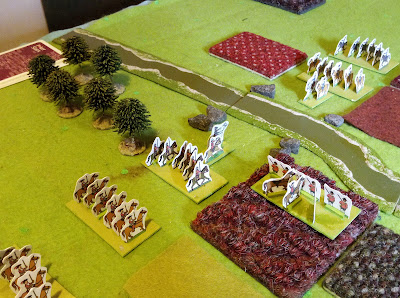I had a little bit of a fiddle around with my ideas for Portable Wargame card activation, and I'm beginning to be swayed to the school of thought that it's maybe a non-issue, and that I'm fixing something that doesn't really need to be fixed. However the discussion has thrown up some interesting ideas for activation mechanisms, and I tried something different last night in a refight of the Action at Powick Bridge (which, owing to me having lost my one decent bridge) became a ford.
This is an interesting action to try with a 'random' turn sequence, as it has reinforcements appearing based on a die roll made each turn, and units testing to see if they recover from surprise each turn. And the problem with the card activation system is that there's no real concept of a turn. It simply allows one side or the other a number of actions.
Now in other games I have treated each reshuffle as the end of a larger turn, allowing me to place a time-limit on the game. This is not unlike Maurice, where you go through the deck three times, and the game then ends. I normally treat six or eight reshuffles as a day of battle. However for this scenario a possible full deck of cards is too large a gap between tests for it to be truly viable.
What I did was create an initiative deck as normal, but include two Jokers. Whenever a Joker appears, the current 'turn' ends, and you test for reinforcements of unit recovery. The deck is reshuffled after the second Joker appears. Essentially each turn is, on average, half a deck, which I thought would give about the right pace.
Anyway, here's the action set up. The Royalists on the right are resting in and around some fields, whilst Parliament's horse, and some attached dragoons, are riding down the road towards the ford. Both sides are surprised to see the other - the yellow markers denote units that are subject to surprise.
Another view of the Parliamentarians.
Parliament has a considerable force of horse off-table, which appears randomly from the second turn onwards.
The Parliamentarians milled around in surprise, aside from their dragoons, whose commander moved them swiftly onto their flank so that he could lay down fire across the river. The Royalists were quick to get their units organised, and galloped to the ford, attacking Parliament's horse as it tried to cross.
Prince Rupert rode forward from the Royalist main body to lead the attack, rashly driving his men into the Parliamentarian advance guard.
The Royalists pushed forward aggressively.
And then Parliament turned the table and drove the Royalists back.
At that point the Parliamentarian main body arrived.
And that's how the rest of the game went. The Royalists drove forward again ...
... and Parliament drove them back.
But Parliament could never quite get over the ford before the Royalists rallied and drove them back. And their troops, whilst numerous, lacked the Royalists dash and quality. But in the narrows confines of the lane and fields they couldn't bring their numbers to bear. One by one their units broke.
Finally the Parliamentarian commander decided to make use of his dragoons, who had been doing a sterling job holding the flank. He brought them out into the lane, hoping their firepower could clear the Royalist horse from the ford and allow his surviving horse a chance to drive forward and bring their dwindling numbers to bear.
It didn't work. Prince Rupert charged the dragoons who, deprived of any real cover, scattered and fled ...
... followed by the horse supporting them. The surviving Parliamentarians routed.
So the action was a convincing Royalist win (although they were only a unit away from being at risk of rout themselves).
The card mechanisms worked fairly well, splitting the game up into believable turns, although because of the confined nature of the action neither side really needed or used more than a couple of activations from each card draw.
I'm actually starting to think that this totally random method of activation may be more trouble than it's worth, and that a turn-based approach is the way to go, but with some limit on how many units activate. I will reread my other posts, and the comments, and try to put something together.















No comments:
Post a Comment